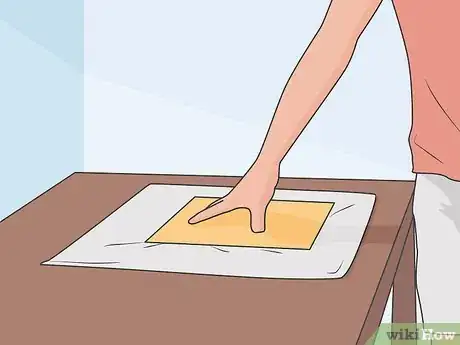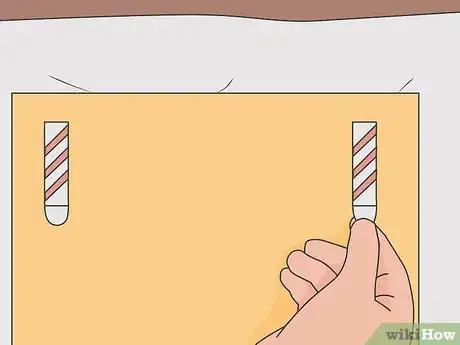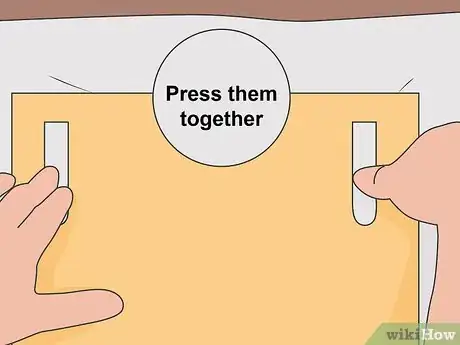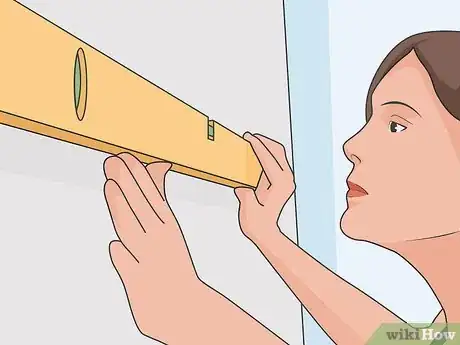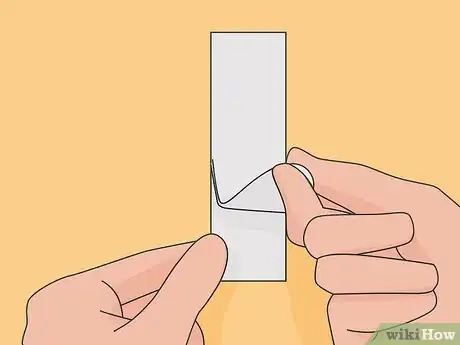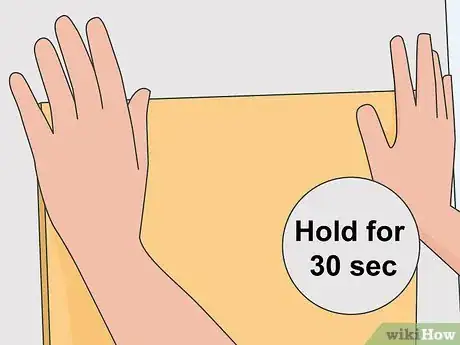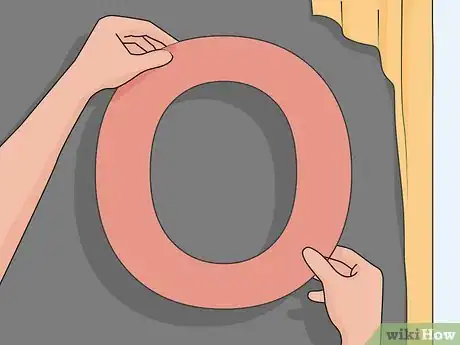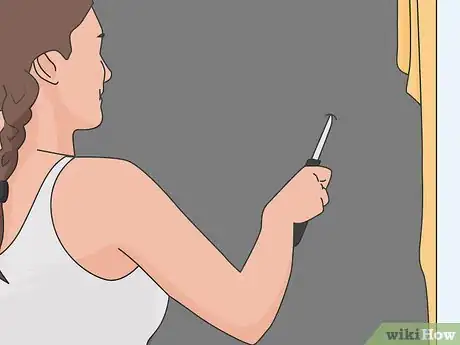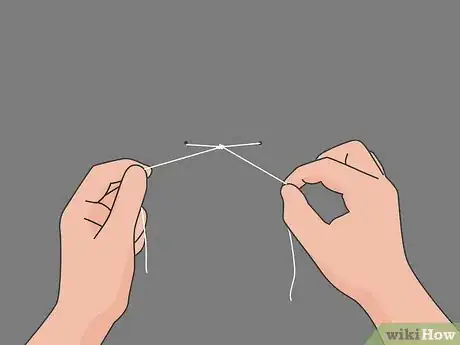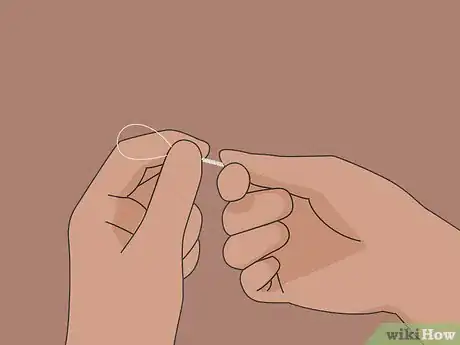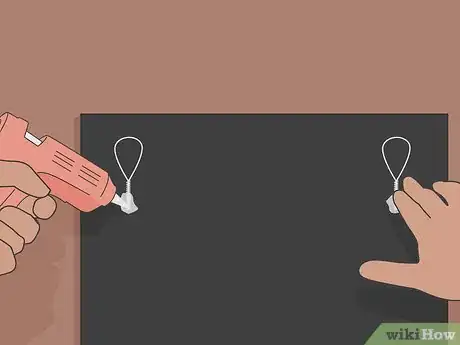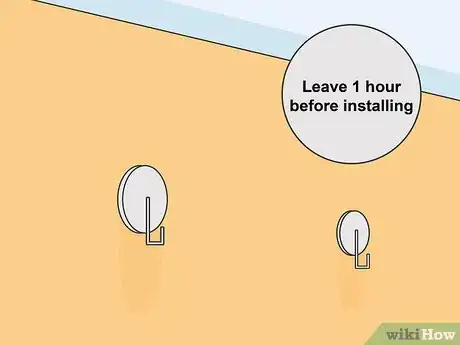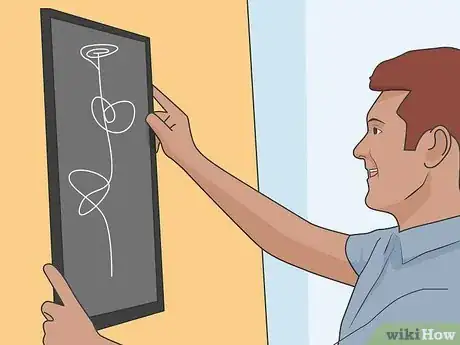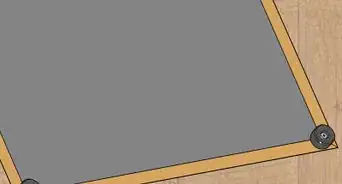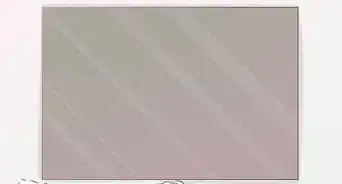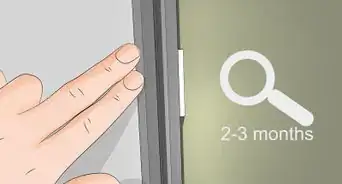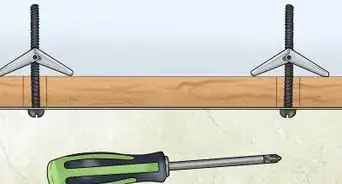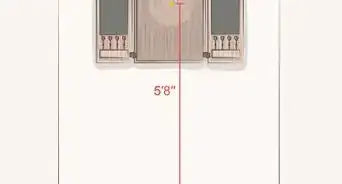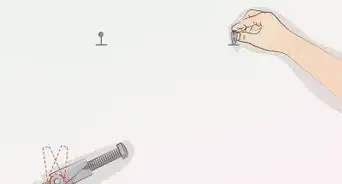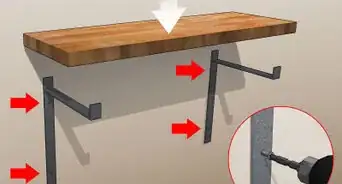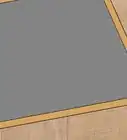This article was co-authored by wikiHow Staff. Our trained team of editors and researchers validate articles for accuracy and comprehensiveness. wikiHow's Content Management Team carefully monitors the work from our editorial staff to ensure that each article is backed by trusted research and meets our high quality standards.
There are 16 references cited in this article, which can be found at the bottom of the page.
This article has been viewed 19,548 times.
Learn more...
Backdrops are an excellent way to express your creativity. They are used as backgrounds in videos and photography, but they can also become beautiful decorations at weddings, parties, and other big events. When you’re designing a backdrop, figuring out how to hang a heavy sign can seem hard, but it’s really not difficult. There are a variety of different hangers and inventive ways to incorporate signs into your plans. With the right material, signs will be a natural part of any backdrop you create.
Things You Should Know
- For an easy way to hang the sign, attach one side of an adhesive velcro strip to the sign and the other side to the backdrop.
- If you're hanging a larger sign, secure it by looping fishing line through holes in both the sign and the backdrop, then tie the line with a sturdy knot.
- You could also attach loops made out of floral wire to the sign, then hang the loops on hooks that are attached to the backdrop.
Steps
Using Adhesive Hanging Strips
-
1Place the sign face down on a clean, soft towel. Spread the towel out over a table to protect the sign from damage. Then, turn it so you’re looking at the side you plan on facing the backdrop. Make sure its corners are clear so you have somewhere to place the hangers.
- Hanging strips and other adhesives work really well on hard, solid backdrops. They can work on softer backdrops if the sign is light enough.
- Adhesive hangers work best with signs that weight less than 5 lb (2.3 kg). There are adhesive hooks that can support more weight. You could also try nailing or tying heavier signs to your backdrop.
-
2Place a hanging strip on each corner of your sign. Take the strips out of the packaging and separate them. Then, peel the adhesive backing off one at a time. If you put one in every corner, your sign will be well-supported and unlikely to fall down. Position the strips all in the same direction, like vertically, if you have room to do it.[1]
- Another option is to use double-sided adhesive tape. Adhesive tape can be a better choice for softer fabric backdrops where hangers might be more visible.
- Note that adhesive hangers or tape will damage soft surfaces like paper and fabric if you attempt to remove them. If you’re hanging a soft sign or plan on removing your sign from a soft backdrop, you should try using something like hanging wire instead.
Advertisement -
3Lay a second adhesive strip velcro-side down over the ones on the sign. Adhesive hanging strips are meant to be used in pairs. Each one has a velcro side. Line up the second strips with the original ones you placed, then press them together so the velcro sides stick. The second set of strips are what will secure the sign to the backdrop.[2]
- Line up the strips as much as possible so they fully stick to one another.
- Adhesive strips are really easy to set up, and any of them you stick together can be pulled apart whenever you need to take down a sign.
-
4Use a level to ensure the sign is even on the backdrop. First, determine where you want the sign to hang. Find a spot where it will be visible while still leaving plenty of room for any other decorations you wish to add. Then, hold the sign against the backdrop to test the positioning. Place a carpenter’s level atop the sign and watch the little capsule of liquid in its center. If the bubble stays centered in the liquid, then the sign is level and will hang evenly on the backdrop.[3]
- Test out the sign’s positioning before peeling the backing off the mounting strips. Once the adhesive strips are on the backdrop, they are difficult to adjust. You will most likely have to replace them if you want to reposition them.
-
5Remove the adhesive backing to stick the sign to the backdrop. Peel off the solid backing on each strip of tape. Then, take the sign over to your backdrop. Once you have figured out the perfect position for it, press it firmly against the backdrop to stick it in place. The hanging strips won’t be visible, so step back and admire how professional your finished backdrop looks.[4]
- If you’re using adhesive tape or another sort of material, you won’t be able to easily remove the sign once it is stuck to the backdrop, so make sure it is where you want it!
- Handle the sign with caution once the cover is off the mounting strips. They stick to everything. Although you can peel them back off, they won’t be as sticky as they were originally.
-
6Hold the sign in place for 30 seconds to secure it to the backdrop. Leave it alone for about 1 hour. After that, you can remove the sign whenever you want. Separate the adhesive strips from one another. You can easily stick the velcro sides back together the next time you’re ready to use the backdrop.[5]
- Adhesive strips are useful for storing a backdrop. Take down the sign, fold up the backdrop, and put it away. The adhesive mounts will be ready the next time you set up the backdrop.
Tying Signs with Fishing Line
-
1Find holes near the sign’s upper corners to use to hang it. Fishing line is great for hanging signs without damaging a backdrop, but it only works if you’re able to knot the line to something. Look for holes near the top edge of your sign. For example, if your sign is made out of cut-out letters, you might be able to string wire through loops in letters like A and O. Select at least 2 spots on opposite ends of the sign.[6]
- If your sign doesn’t have any holes yet, consider drilling a few through it. You could use a small drill bit to make a pair of holes 1⁄2 in (1.3 cm) from the upper corners of the sign, for instance.
- Fishing line is effective since it’s strong and transparent. It’s also somewhat difficult to knot. There are many other types of wires and ropes you can use as well.
-
2Position the sign on the backdrop and test it with a level. Place the sign on the backdrop like you’re ready to hang it. Once you know where you want it, place a carpenter’s level on top of it. Watch the bubble in the center of the level to see if it moves. If it stays in the center, then the sign is level.[7]
- If the backdrop doesn't have holes to run the fishing line through, use the sign’s placement to figure out where to make them. They should be right underneath the holes in the sign.
- If you’re going to poke holes through the backdrop, use the level to ensure the holes are level with one another. Mark the spots in pencil so you know where to make the holes.
-
3Poke holes through the backdrop if it doesn’t already have any. Determine where you’re going to hang the sign, then place a couple of holes there. You could use a small drill bit, like one that is 1⁄64 in (0.040 cm) in diameter, to dig through solid material. If your backdrop is made of something softer, like cardboard, you could poke out holes with a utility knife, a hole punch, or another tool.[8]
- You will only need 2 holes to hang most signs. Position the holes so they will be hidden behind the sign when you hang it later. No one will even realize they are there!
- Tying up signs is really easy if you have something like a boxwood or hedge backdrop. Slip the wire between the leaves, then bind it to the supports on the back!
-
4String the fishing line through the holes in the sign and backdrop. Start with one of the holes, passing the tail end of the line through the sign and then the backdrop. Don’t cut it from the reel just yet. It’s best to wait until you’re certain of what length you need. Try to position the sign so it’s flat against the backdrop.[9]
- To tie up the sign, run a separate length of line through each hole. It is possible to tie the sign up with a single wire, but tying up each side individually is usually easier.
- If you’re looking for a different way to tie up your sign, you could use ribbon. It will be visible, but it could add some color to your backdrop. You could also use rope, picture wire, or another alternative.
-
5Use scissors to cut the line an extra 12 in (30 cm) long. Measure out 6 in (15 cm) on both ends so you have a little extra room to knot the line. Then, trim the line off from the reel. If you don’t have scissors, another sharp blade or pliers will also work.[10]
- Always cut the line a little longer than you think it needs to be. If it’s too long, you can trim the excess off afterward.
-
6Knot the line behind the sign and the backdrop. Fishing wire can be a little tricky to knot if you’re unused to working with it. To keep your sign supported, take advantage of a knots commonly used in fishing, such as Palomar knots. To create the knot, loop the line back through the hole in both the sign and backdrop. Pull the loop back over itself to create a simple overhand knot, then cut off the excess line.[11]
- If you’re unused to tying different knots, try them out on a spare piece of fishing line. Regular knots usually aren’t strong enough to hold a backdrop together.
-
7String the sign to a support if you wish to protect the backdrop. Instead of poking holes in the backdrop, find something up above to hitch your sign to. Backdrops are generally suspended from something, such as a curtain rod. Loop the fishing line around the overhang to knot the sign to it. The fishing line will be a little more exposed, but, from a distance, it will look like it’s floating in midair.
- Hanging a sign this way gives your backdrop a different sort of flair. If you have multiple decorations, you could hang some and tie others directly to the backdrop to make it full and colorful.
Using Floral Wire and Glue
-
1Cut a piece of wire to 9 in (23 cm) to create a hanging loop. If you’re hanging a small, lightweight sign, you can get away with using a single piece of wire. If you’re planning on putting up something wooden that is more than 6 in (15 cm) in length or width, trim off at least 2 wires. You can install a loop in each corner to keep the sign better secured to the backdrop.[12]
- There are many different types of wires you can use for your sign. Floral wire is painted to blend in with green backdrops. Try using 18-gauge metal wiring for more durability.
- It is also possible to use pieces of rope, twine, ribbon, or other material, depending on how you want the finished decoration to look. Most hanging material, such as ribbon, can’t support much weight, but it looks nice against the right backdrop.
-
2Fold and twist the wire into a loop. Fold the wire in half, then twist the ends together. Twist about ¾ of the wire together to leave a nice, big loop at the end. Create another loop from a separate length of wire to support the opposite end of the sign as well.[13]
- Plan on using a separate loop for each of the upper corners, but make sure you are able to place them roughly the same distance from the sign’s edges. If they aren’t spaced out properly, the sign could end up looking a little crooked once you hang it.
-
3Position the wires about 1⁄2 in (1.3 cm) from the sign’s upper corners. Spread out a clean towel to protect the sign, then flip it so the back is face up. Place the wire loops close to the corners, but not too close to the top edge of the sign, or else they may be visible when you hang it later. Position the loops so they are on top with the twisted ends firmly against the sign.[14]
- If you’re trying to hang a small sign or decoration, position the loop directly in the center. You can use this technique to hang paper flowers, for instance, but it works for signs as well.
- Add extra loops to the lower corners if you need to for additional support.
-
4Glue the ends of the wire to the back of the sign. Warm up a hot glue gun for about 1 minute. Once it’s hot, spread a dab of glue underneath the twisted part of each wire. Press them down against the sign so they stick in place.[15]
- If you don’t have a hot glue, use another adhesive, like double-sided tape or a craft glue.
- Another option is to use adhesive pins. Stick them to the back of the sign, then pin it to the backdrop. You will end up having to put holes through some backdrops to get this to work.
-
5Place hooks on the backdrop if you don’t have anywhere to hang the sign. You can use hooks when you’re dealing with a solid backdrop. Get some adhesive-backed hooks, then stick them onto the backdrop. Leave them alone for about 1 hour before installing any decorations over them.[16]
- If you have a sturdy backdrop, or have a wall behind the backdrop, you could hammer nails through it for hangers.
- You could also loop the wire through the backdrop before gluing it or place pieces of double-sided tape under it for extra support.
-
6Loop the wire over the hooks to hang the sign. Stand the backdrop up, then check that the hooks are secure. If they are stuck in place, set the wire loops on them. Position the sign and other decorations to help cover the hooks and any exposed wiring. When you’re done, step back and admire the cool decoration.[17]
- To help cover hangers, fill the backdrop with other decorations, like balloons or flowers. For example, you might leave the base layer of the backdrop exposed, but no one will see it if you fill in the space by gluing or stringing up colorful decorations.
Warnings
- Hot glue guns and other tools can be dangerous, so take all possible safety precautions when using them. For example, don’t leave a glue gun near flammable objects and keep your fingers away from the tip to avoid burning them.⧼thumbs_response⧽
Things you’ll Need
Using Adhesive Hanging Strips
- Adhesive hanging strips or an alternative
- Carpenter’s level
Tying Signs with Fishing Line
- Fishing line
- Scissors
- Drill, utility knife, or an alternative
- Level
Using Floral Wire and Glue
- Floral wire
- Scissors
- Hot glue gun
- Hot glue
- Hooks or nails
References
- ↑ https://www.youtube.com/watch?v=6bTdtnzPmOE&feature=youtu.be&t=53
- ↑ https://www.bobvila.com/slideshow/12-ways-to-hack-your-life-using-velcro-48802#flower-bed-ideas
- ↑ https://www.bobvila.com/articles/499-levels/
- ↑ https://todayshomeowner.com/how-to-hang-anything-on-anything/
- ↑ https://todayshomeowner.com/how-to-hang-anything-on-anything/
- ↑ https://www.youtube.com/watch?v=mBZe6uG26FY&feature=youtu.be&t=168
- ↑ https://www.bobvila.com/articles/499-levels/
- ↑ https://www.youtube.com/watch?v=Lr7kMaKrVbo&feature=youtu.be&t=366
- ↑ https://www.youtube.com/watch?v=pREahWiiZVQ&feature=youtu.be&t=698
- ↑ https://www.youtube.com/watch?v=Lr7kMaKrVbo&feature=youtu.be&t=393
- ↑ https://www.youtube.com/watch?v=hTi_-sIHkRk&feature=youtu.be&t=320
- ↑ https://www.youtube.com/watch?v=ILAQweYC6qY&feature=youtu.be&t=337
- ↑ https://www.youtube.com/watch?v=06vXz_iDP2c&feature=youtu.be&t=238
- ↑ https://www.youtube.com/watch?v=Vtf6dfMThqg&feature=youtu.be&t=725
- ↑ https://www.youtube.com/watch?v=ILAQweYC6qY&feature=youtu.be&t=431
- ↑ https://www.youtube.com/watch?v=hTi_-sIHkRk&feature=youtu.be&t=329
- ↑ https://www.youtube.com/watch?v=ILAQweYC6qY&feature=youtu.be&t=704
- ↑ https://www.diyphotography.net/how-to-make-your-own-diy-mottled-backdrops-for-a-fraction-of-the-cost-of-buying-them/
